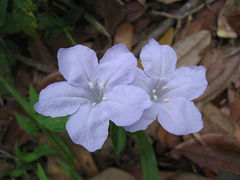Ruellia
| Ruellia subsp. var. | ||||||||||||||||||||||||||||||||||||||||||||||||||||||||
|---|---|---|---|---|---|---|---|---|---|---|---|---|---|---|---|---|---|---|---|---|---|---|---|---|---|---|---|---|---|---|---|---|---|---|---|---|---|---|---|---|---|---|---|---|---|---|---|---|---|---|---|---|---|---|---|---|

|
|
| ||||||||||||||||||||||||||||||||||||||||||||||||||||||
| ||||||||||||||||||||||||||||||||||||||||||||||||||||||||
Ruellia (Wild petunia; syn. Aphragmia, Arrhostoxylum, Copioglossa, Dinteracanthus, Dipteracanthus, Eurychanes, Nothoruellia, Sclerocalyx, Stenoschista) is a genus of plants in the family Acanthaceae.
| Standard Cyclopedia of Horticulture |
|---|
|
Ruellia (after Jean de la Ruelle, a French botanist). Syn. Stephanophysum. Acanthaceae. Villous, pubescent or rarely glabrous herbs or shrubs, a few species grown under glass and also outdoors mainly in the South. Leaves opposite, entire or rarely dentate: fls. shades of blue or purple to violet, white, rose to red and rarely yellow to orange, sessile to long-peduncled, axillary, solitary or fascicled or cymose paniculate; calyx deeply 5-cleft or 5-parted, segms. linear or lanceolate; corolla-tube straight incurved or abruptly inflexed, the limb spreading, the lobes ovate or rounded; stamens 4, didynamous: caps, oblong-linear or clavate. About 200 species, chiefly Trop. S. Amer., a few in N. Amer. and extra-Trop. S. Amer., some in Trop. and S. Afr., Temp. Asia and in Austral. R. solitaria, Veil., is offered in the European trade, but its identity is doubtful, as R. solitaria, Vell., has been referred by some to R. Schnaeriana, Lindau, by others to R. calvescens, Lindau.—R. varians, Vent., is Daedalacanthus nervosus.
|
Cultivation
Propagation
Pests and diseases
Species
- Ruellia acutangula Nees ex Mart.
- Ruellia amoena Nees
- Ruellia angustifolia Sessé et Moc.
- Ruellia angustior (Nees) Lindau
- Ruellia asperula Benth. et Hook.f.
- Ruellia brevicaulis Baker
- Ruellia capitata D.Don
- Ruellia (Scorodoxylum) costata Hiern
- Ruellia (Scorodoxylum) costata (Nees) Hiern var. latifolium Nees
- Ruellia (Scorodoxylum) costata (Nees) Hiern var. salicifolium Nees
- Ruellia densa Hiern
- Ruellia diffusa Royle ex Nees
- Ruellia dissitifolia Hiern.
- Ruellia eriocalyx Glaz.
- Ruellia eurycodon Lindau
- Ruellia flava Roxb.
- Ruellia formosa Andrews
- Ruellia geminiflora Kunth
- Ruellia glanduloso-punctata Lindau
- Ruellia hapalotricha Lindau
- Ruellia helianthemum (Nees) Lindau
- Ruellia humilis Pohl ex Nees
- Ruellia hypericoides Lindau
- Ruellia incomta Lindau
- Ruellia macrantha Mart. ex Nees
- Ruellia menthoides Hiern
- Ruellia neesiana Lindau
- Ruellia (Dipteracanthus) nitens (Nees) Wassh.
- Ruellia (Dipteracanthus) pohlii Nees
- Ruellia puri Mart. ex Nees
- Ruellia rasa Hiern
- Ruellia rufipila Rizzini
- Ruellia stenandrium Pohl ex Nees
- Ruellia tomentosa Wall.
- Ruellia trachyphylla Lindau
- Ruellia trivialis Blanch. ex Nees
- Ruellia tweediana Griseb.
- Ruellia (Eurychanes) verbaciformis Nees
- Ruellia villosa Lindau
- Ruellia vindex Mart. ex Nees
Gallery
-
photo 1
-
photo 2
-
photo 3
References
- Standard Cyclopedia of Horticulture, by L. H. Bailey, MacMillan Co., 1963
External links
- w:Ruellia. Some of the material on this page may be from Wikipedia, under the Creative Commons license.
- Ruellia QR Code (Size 50, 100, 200, 500)
